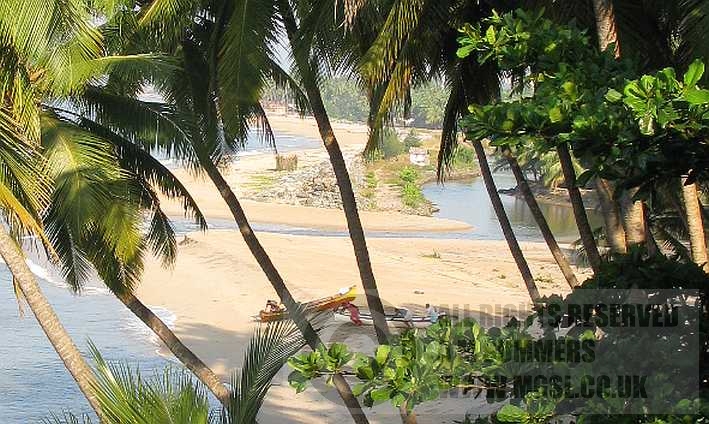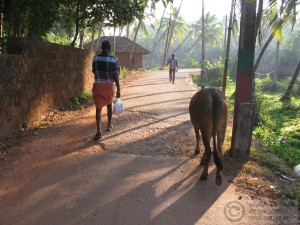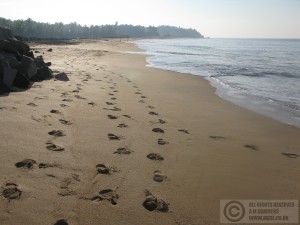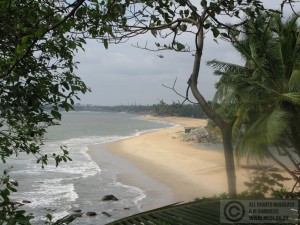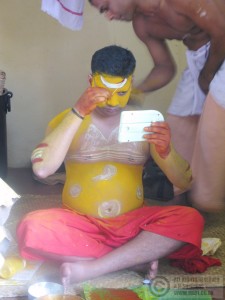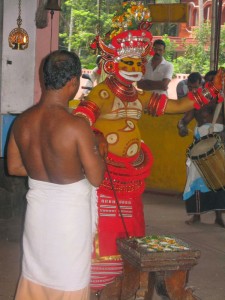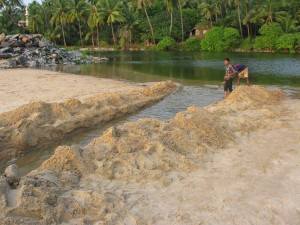The owner of the Sea Shell resort had arranged for a tuk tuk driver to meet us at the railway station – it’s a tight squeeze in a tuk tuk when we have all our luggage, but we manage for short distances. In the UK drivers consider a route as a shortcut if it saves time – in India its purpose is to save diesel, never mind if it takes twice as long. And a shortcut appeared to be what our tuk tuk driver was taking as we veered down narrow potholed streets close to the sea shore, through a humble Muslim residential area.
The Muslims in this part of India have a different culture from those elsewhere. Across most of India the Islamic influence came from the north and the Mughals of Persia – the Mappila, or Moplah, Muslims of Kerala have older origins, influenced by Arab traders as far back as the 7th century. They have their own language, a mix of Arabic and Malayalam, and most married women here appear to wear abayas (something rarely seen in other parts of India – even hijabs used to be uncommon but perhaps becoming less so).
It was definitely not a tourist area (not that Kannur sees many western tourists anyway), and the sight of two foreigners clinging on for dear life as the tuk tuk bucked and reared its way along a road whose tarmac had all but disappeared resulted in a significant number of dropped jaws. Then any pretence of tarmac vanished and we were onto the red dirt of Tippu Sulthan Beach Road – although calling it any kind of road was a bit optimistic, I think. It was just as well that the manager had sent the tuk tuk – a driver picked at random from the gaggle at the station would never have found the place. It was worth the trip though, as we were shown to a room with a verandah that looked out from the cliffs to a long beach below (free room upgrade as there were few other guests) and brought cool lemon water.
The Sea Shell is not really a hotel, more like a boarding house, where your meals are provided and you eat what you are given – it’s up to you to say if you want something in particular, or want to avoid certain things. We ticked the Veg box on the check-in form, and were asked if veg biriyani was OK – I’m not sure what would have happened if we’d had a rice allergy, since it featured heavily over the three days we spent there. The dahl accompanying the biriyani was rather bland the first night, so when the owner enquired anxiously if it had been too spicy, we asked him to tell the staff to just cook as they would for Indian guests. We chickened out slightly on day two, not over the spiciness (which gradually increased during our stay, as we proved we really could handle it) but just because of the amount of food. Breakfasts were substantial Keralan fare (puri bhaji and uppma, idiyapam and potato curry, puttu and chickpea curry), lunches and dinners were rice and chapattis with curries – too much, and very heavy on the starch. So we asked for fruit salad for lunch after the first day, which was willingly provided.
We had discussed the possibility of going to a theyyam while we were there, but had thought it might require a long trip and be difficult to find one, but Mr Haris, the owner, told us when we arrived that one would take place the following evening not far away, so it was arranged that Bapu, our tuk tuk driver, would take us. Theyyam ceremonies involve elaborate costumes and make up not dissimilar to kathakali, but they are religious ceremonies rather than theatrical performances, and take place only once a year at some temples in northern Kerala (and may go on all night) but this particular temple had one weekly.
As I expected, a dozen other tourists were at the small urban temple when we arrived, sitting on a row of plastic chairs. However as more locals drifted in we were soon outnumbered, and it became clear that this was a genuine ceremony, not a staged event for tourists. The Charappuram Sree Muthappan Kshethram temple at Thilannur is a very simple one – just a small shrine with a covered concrete area in front of it, beyond which was an office and a tiny room where a pot was heating on an open fire, creating an unpleasant pall of smoke that drifted across our seating area. Luckily this didn’t last long – the pot contained chai, and it was soon taken off to be sold to the attendees.
Behind the shrine was a small room where a man was completing his make up for the ceremony. A spirited drumming and blowing of a horn announced his arrival, at which point we were clearly expected to stand. Of course, we had no idea what was happening as he, and another man dressed only in a lunghi, danced around in the area in front of the shrine, doing things with rice and strips of banana leaf and individually blessing the male worshippers, but from his make up we guessed that he represented Hanuman, the monkey incarnation of god. The ceremony lasted an hour, and we went to the temple office to make a donation (carefully noted and a receipt given) before returning to the Sea Shell.
The rest of our time at the Sea Shell was spent simply strolling along the beach or the lanes around the hotel. A river cuts through just north of the hotel and in the wet season flows into the sea, but at this time of year it just creates a lagoon behind the beach. On the second day of our stay men from the village dug a trench across the beach to allow water from the lagoon to flow out. We weren’t convinced that the exercise would be successful, but that night the sea did the rest and by morning there was a wide shallow channel, large enough for the fishing canoes to pass through. Haris told us that they did it to clean out the lagoon – probably it also made it a bit salty and kills the mosquito larvae. However their work won’t last long – the channel will fill and have to be re-dug many times until the next monsoon arrives.
Our journey from Kannur was another early start as Bapu took us back to the station by the same route as we’d arrived. At this time of day the streets by the shore were busy with people and trucks and hundreds of plastic crates containing the night’s catch. Luckily this train was on time – but we’d lost about half an hour by the time we got to Ernakulum seven hours later.


